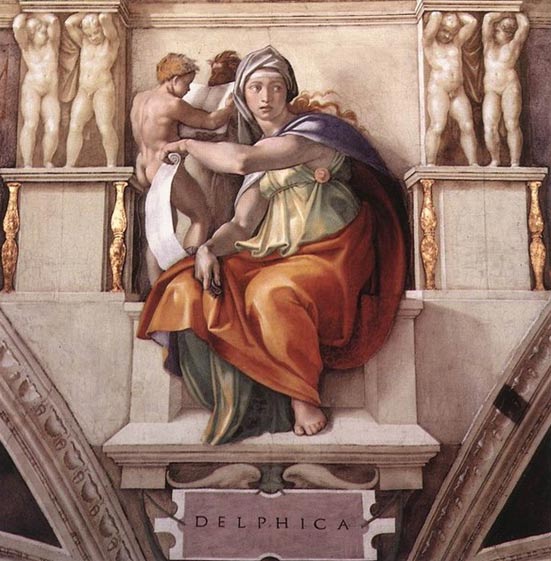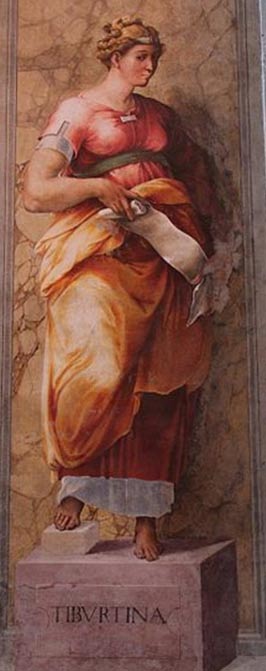
The Terrifying Doomsday Prophecy of the Tiburtine Sibyl
The word sibyl comes from the Greek term sibylla, meaning prophetess. Legends of the sibyls have been known since ancient times. In the beginning, their prophecies were foretold at holy sites, often under the influence of a particular deity. In later times sibyls lived like wanderlusts, traveling with their predictions and followers from one place to another.
The earliest Greek writer known to mention a sibyl is Heraclitus, who writes in fragment 92 of his work: "The Sibyl, with frenzied mouth uttering things not to be laughed at, unadorned and unperfumed, yet reaches to a thousand years with her voice by aid of the god."

Sibyl of Cumae. (1489-1491) By Filippino Lippi. (Public Domain)
Ten Women Who Knew the Future
It is unclear how many women are labelled in history as just one sibyl. Roman writers usually refer to sibyls with names that refer to the location of their shrine. However, both Heraclitus and Plato speak of only one sibyl.
Over the course of time, the number of sibyls increased to ten. According to Lactantius' Divine Institutions (which was written in the 4th century AD, quoting from a lost work of Varro from the 1st century BC) these ten sibyls were: The Persian, The Libyan, The Hebrew, The Delphic, The Cumaean, The Erythraean, The Samian, The Hellespontine, The Phrygian, and The Triburtine Sibyl.

The Delphic Sibyl. (1509) By Michaelangelo. Sistine Chapel, Vatican City. (Public Domain)
Three of the most famous sibyls throughout their long career were the Delphic, the Cumaean, and the Erythraean. Nonetheless, not all of them were securely identified with an oracular shrine and hearth. In the vague and shifting Christian picture there is some overlap in the accounts of sibyls.
But for the Romans the most mysterious and impressive sibyl was the tenth – the Tiburtine Sibyl. She was probably Etruscan in origin and became one of the most legendary women of ancient Etruria.
- Dreams and Prophecy in Ancient Greece
- The Ancient Roots of Doomsday Prophecies and End of the World Beliefs
- Pythia, The Oracle of Delphi
The Tenth Sibyl’s Famous Prediction
To the group of classical nine sibyls of the Hellenistic and Middle Eastern world, the Romans added a tenth one. She was called the Tiburtine Sibyl. Her seat was the ancient Sabino-Latin town of Tibur (modern Tivoli). Although the most famous monuments of Tivoli come from the 16th century, Tibur in her times was the same wonderful garden of beautiful buildings and landscapes. It was also the location of the legendary meeting of Augustus with the sibyl.

The Tiburtine Sibyl, 1483. Fresco in Church of St. John the Evangelist in Tivoli, Italy. (CC BY SA 2.0)
According to legend, the reason behind the encounter was that Augustus wanted her to answer whether he should be worshiped as a god, or not. Later the story of this meeting became a favored motif of Christian artists. Although it is not completely certain whether the sibyl in question was the Etruscan Sibyl of Tibur or the Greek Sibyl of Cumae, the Christian author Lactantius had no hesitation in identifying the sibyl in question as the Tiburtine Sibyl, and many scholars have concurred.

The Tiburtine Sybil's prophecy to the Emperor Augustus. (1480-1485) By Städel. (Public Domain)
Lactantius gave a circumstantial account of the sibyls that is useful as a guide to their identification. According to him, The Tiburtine Sibyl's name was Albunea. She was worshiped at Tibur as a goddess and her shrine was located near the banks of the Anio.
Legends say that she always held a book in her hand and her oracular responses were transferred by the Senate into the capitol. Her famous work was written circa 380 AD but it did not become widely known until there were revisions and interpolations added at later dates. The content of this text describe an Emperor named Constans vanquishing the foes of Christianity and bringing about a period of great wealth and peace, ending paganism, and converting the Jews. The prophecy became famous in ancient times, mostly because of a single sentence: ''The king of the Romans will claim the whole Christian empire for himself'.'

Tiburtine Sibyl Montfoort engraving (1575) by Philip Galle. (Public Domain)
The Apocalypse Prophecy
Thus, the prophecy became a bestseller of its times. The ancient text is an interpretation of the Tiburtine Sibyl’s dream in which she foresees the downfall and apocalyptic end of the world. The content was so shocking that for centuries readers were scared of what they imagined to be the impending image of 9 suns appearing in the sky, with each one uglier and more bloodstained than the last. These suns were supposed to represent the 9 generations of mankind and their procession was thought to end with Judgment Day.
- The Mystery of the Roman Tunnels of Baiae
- The Warriors of the Rainbow Prophecy
- Hopi Prophecy and the End of the Fourth World - Part 1
Copies of the Prophecy
To date there are over 100 known manuscripts referring to the prophecy from the 11th to the 16th century. The number of surviving copies is so high because of the shocking (and sometimes useful) content. The prophecy predicts, among other things, the reign of evil despots, the return of the Antichrist, and the sun turning to blood.
The earliest English translation of the prophecy is usually linked to the larger monastic houses such as Rochester and Canterbury, where political prophecies such as the Prophecies of Merlin were popular works. The Tiburtine Sibyl’s prophecy is also one of the most famous manuscripts in the Irish volume from the late 13th or early 14th century which contains a version of the Topographia Hibernica of Giraldus Cambrensis.

The Tiburtine Sibyl with a document. (c. 1540) Church of Santissima Trinità dei Monti, Rome, Italy. (Public Domain)
Another of the most precious manuscripts including the prophecy of the Tiburtine Sibyl is the historical and theological annals of Abingdon and the Historia Regum Britanniae, which is thought to be from Abingdon Abbey.
Some other important copies of the manuscript are: a 13th-century edition in a collection with the Pantheon of Godfrey of Viterbo and Apollonius of Tyre, an early 14th century manuscript containing a Chronicle of Worcester Cathedral Priory up to 1377, and a composite manuscript which contains a version of the prophecy from the 13th century. Thus the prophecy of the Tiburtine Sibyl not only made an impact during her lifetime, but the words she wrote also well outlived the creator of the divinatory text.
Featured Image: ‘Augustus and the Sibyl’ (1575-1580) by Antoine Caron. Louvre Museum, Paris, France. Source: Public Domain
By: Natalia Klimczak
References
Anke Holdenried, The Sibyl and Her Scribes: Manuscripts and Interpretation of the Latin ‘Sibylla Tiburtina c.1050-1500, 2006
Arianna Pascucci, L'iconografia medievale della Sibilla Tiburtina, 2011
Erminio Morenghi, Nel segno della Sibilla Tiburtina, 2014
http://britishlibrary.typepad.co.uk/digitisedmanuscripts/2015/11/beware-the-sybils-prophecy.html
http://http-server.carleton.ca/~jopp/3850/1-1.htm















Comments
I LIKE TO KNOW MORE ABOUT THE PAST AND THE FUTURE BECAUSE THERE NO SUCH STATE AS "PRESENT"